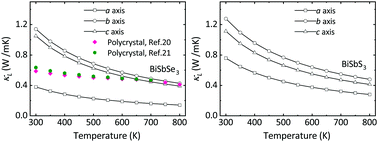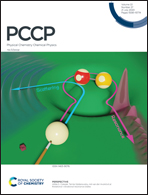Microscopic origin of the extremely low thermal conductivity and outstanding thermoelectric performance of BiSbX3 (X = S, Se) revealed by first-principles study†
Abstract
In this paper, we performed comprehensive investigations of both the thermal and electrical transport properties of BiSbSe3 and BiSbS3 by using first-principles calculations and Boltzmann transport theory. Due to the repulsion between the lone-pair electrons of Sb and the p orbital of Se(S), both BiSbSe3 and BiSbS3 show strong anharmonicity with Grüneisen parameters of 1.90 and 1.79, respectively. As a result, these two materials possess extremely low lattice thermal conductivities. Meanwhile, both BiSbSe3 and BiSbS3 exhibit similar anisotropic thermal transport behaviors, which is due to the smaller phonon group velocities along the a axis. The predicted highest ZT values at 750 K are 2.9 for n-type BiSbSe3 and 1.2 for p-type BiSbS3. Our calculations provide insights into the origin of the extremely low thermal conductivity in BiSbSe3 and BiSbS3, which is meaningful for exploiting high performance thermoelectric materials with low thermal conductivity.



 Please wait while we load your content...
Please wait while we load your content...